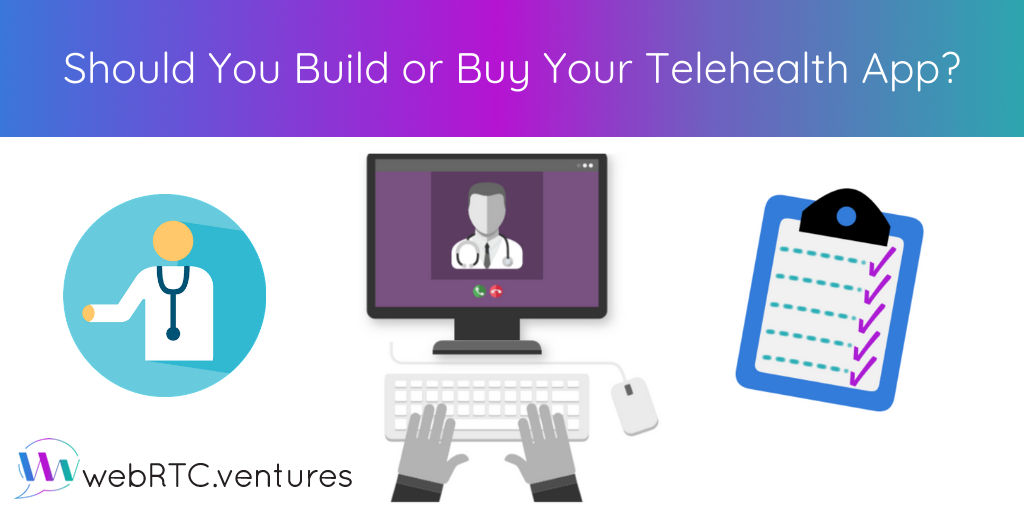Should you build or buy your telehealth application? There are often many choices and factors to consider. How much will a telehealth application cost? How much time will it take to implement? This post explores a range of options – from those that require the least amount of custom software development to those that require the most complex development and integration efforts.
From the least upfront IT effort to the greatest amount of complexity:
-
License an existing solution
- Pros: Minimal upfront effort required, and the IT vendor handles the compliance and security issues
- Cons: Typically the most expensive option with limited ability to customize to your business processes or integration points
- Timeline: Days or weeks
-
Build on an enterprise conferencing platform
- Pro: Likely to have strong video quality based on existing conferencing tools
- Con: Not usually “pure WebRTC” solutions. These platforms will not take as much advantage of the peer-to-peer (P2P) architecture of WebRTC. These solutions typically use WebRTC as a gateway into their proprietary video conferencing solution.
- Consider vendors like Agora.io and Vidyo.io
- Timeline: 2 to 6 months
-
Build on a WebRTC CPaaS
- Pros: Very customizable APIs and building blocks that are targeted to developers. These give you a lot of flexibility in how you implement video in your application. You often have the choice between using pure P2P WebRTC solutions or the IT vendor’s media servers for more scalable and higher quality calls.
- Cons: HIPAA-compliant solutions may come at a higher cost than normal pricing. The APIs and servers are controlled by the vendor, so you’re basically renting them to use for your application. It may take some time for the vendor to implement the latest WebRTC features in their APIs.
- Consider vendors like Tokbox, Twilio Video, Xirsys, and PhenixP2P
- Timeline: 2 to 6 months
-
Build on top of a media server
- Pros: You control all the server hardware. This means that you manage the systems and can certify to your users that you have complete control over
all the security and infrastructure of your application. You aren’t building completely from scratch; you can license a media server or start with an open-source implementation. Building on top of a media server also offers lower per-minute costs than CPaaS solutions. You don’t own the intellectual property of every piece of your solution, but you own most of it.
- Con: You control all the servers, which means you also have to implement all the security measures and regularly update your media server to implement the latest WebRTC standards improvements. This will have large ongoing costs for development and application maintenance.
- Consider media servers like SwitchRTC, Kurento, and Jitsi
- Timeline: 2 to 6 months
- Pros: You control all the server hardware. This means that you manage the systems and can certify to your users that you have complete control over
-
Implement your own WebRTC solution
- Pros: You control it all, and you can build your own custom media servers. You own all the intellectual property associated with your solution.
- Con: You have to build it all. This will be expensive and time-consuming. You need a compelling reason to try to re-invent a better wheel.
- Timeline: 1 year
You have several options here, and the lines between these options aren’t always clear-cut. Your results may vary, of course. Begin by considering the trade-offs listed above, and balance them against the funding and timeline constraints of your telehealth initiative.
Think a telehealth solution may be right for your healthcare business? Need help determining which option best suits your needs?
The heathcare industry has its own unique set of needs for communications applications, and we’re experts in building secure, HIPAA-compliant video applications for medical providers. We can help you decide whether you want to build a custom telehealth application or enable a telehealth starter kit that already includes the most popular features our clients need and can be licensed, customized, and branded to your unique medical or mental health practice. Contact us today!
[kleo_divider type=”full|long|double|short” double=”yes|no” position=”center|left|right” text=”” class=”” id=””]
Related Posts:
Why You Should Consider WebRTC Video for Telehealth?
How to Implement a Telemedicine Solution
How to Make Sure Your Telehealth Video App is HIPAA-Compliant














